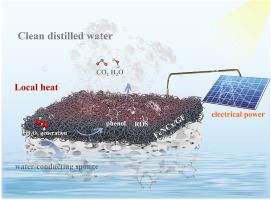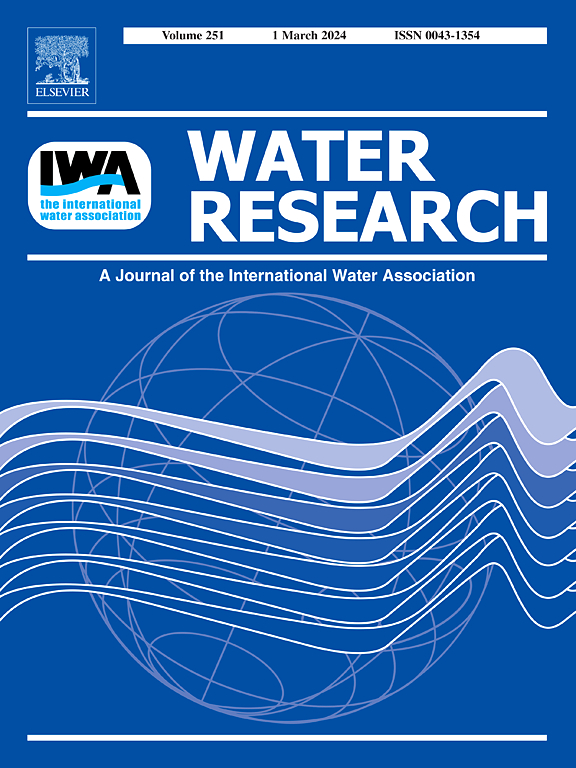通过与电-芬顿相结合,在太阳能界面蒸发中共同促进挥发性有机化合物降解和蒸汽生成
IF 11.4
1区 环境科学与生态学
Q1 ENGINEERING, ENVIRONMENTAL
引用次数: 0
摘要
本文章由计算机程序翻译,如有差异,请以英文原文为准。

Co-enhancing volatile organic compound degradation and steam generation in solar interfacial evaporation by integrating with electro-Fenton
Solar interfacial evaporation (SIE) process offers an effective and sustainable approach for alleviating freshwater shortage, but the simultaneous evaporation of volatile organic compound (VOC) limits the application of this technique. Herein, a novel electro-Fenton assisted SIE (EF/SIE) was proposed for the first time to co-enhance steam generation and VOC removal based on an evaporator composed of graphite felt decorated with Fe/N-doped porous carbon (FeNCx/GF). This dual functional evaporator integrating photothermal and electrocatalytic technology achieved a “self-sufficient” degradation process, in which FeNCx acted as the heterogeneous electrocatalyst to in-situ produce H2O2 and reactive oxidizing species (ROS) for VOC degradation at evaporator interface. As a result, the VOC removal efficiency of EF/SIE system achieved 97.8±1.7% in the condensate, which was 4.8 times that of the sole SIE system. Meanwhile, due to the Joule heating during electro-Fenton process, the conversion rate from water to vapor was accelerated, reaching an evaporation rate to 1.65 kg m-2 h-1 at the cathodic interface, while that of the sole SIE system was only 1.43 kg m-2 h-1. Additionally, an external solar cell enabled complete photo-electro-thermal conversion that ensured an excellent VOC removal efficiency (99%) of the EF/SIE system in the outdoor experiment. The innovatively designed system also showed versatility in different water substrates. Thus, the dual functional evaporators successfully integrated SIE with EF, providing a sustainable and synergetic strategy for efficient treatment of wastewater containing VOC.
求助全文
通过发布文献求助,成功后即可免费获取论文全文。
去求助
来源期刊

Water Research
环境科学-工程:环境
CiteScore
20.80
自引率
9.40%
发文量
1307
审稿时长
38 days
期刊介绍:
Water Research, along with its open access companion journal Water Research X, serves as a platform for publishing original research papers covering various aspects of the science and technology related to the anthropogenic water cycle, water quality, and its management worldwide. The audience targeted by the journal comprises biologists, chemical engineers, chemists, civil engineers, environmental engineers, limnologists, and microbiologists. The scope of the journal include:
•Treatment processes for water and wastewaters (municipal, agricultural, industrial, and on-site treatment), including resource recovery and residuals management;
•Urban hydrology including sewer systems, stormwater management, and green infrastructure;
•Drinking water treatment and distribution;
•Potable and non-potable water reuse;
•Sanitation, public health, and risk assessment;
•Anaerobic digestion, solid and hazardous waste management, including source characterization and the effects and control of leachates and gaseous emissions;
•Contaminants (chemical, microbial, anthropogenic particles such as nanoparticles or microplastics) and related water quality sensing, monitoring, fate, and assessment;
•Anthropogenic impacts on inland, tidal, coastal and urban waters, focusing on surface and ground waters, and point and non-point sources of pollution;
•Environmental restoration, linked to surface water, groundwater and groundwater remediation;
•Analysis of the interfaces between sediments and water, and between water and atmosphere, focusing specifically on anthropogenic impacts;
•Mathematical modelling, systems analysis, machine learning, and beneficial use of big data related to the anthropogenic water cycle;
•Socio-economic, policy, and regulations studies.
 求助内容:
求助内容: 应助结果提醒方式:
应助结果提醒方式:


